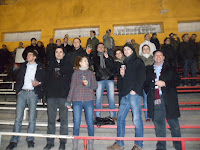Tea is very popular here in the ČR. Or rather, hot tea is very popular here. It is quite common to go for a tea break before lunchtime or in the late afternoon.
In the USA, we drink more iced tea. And in Atlanta, as in most of the South, they drink "sweet tea" (iced tea that was brewed with a kilo or two of sugar). Over here, you can only get iced tea in bottles. When I visit Atlanta in September I want to find a sun tea pitcher, to bring back with me, so that I can have real iced tea over here.
I've been told that back in the days of socialism, that there was only one kind of black tea available. Some Russian brand and not very good. It's a different world now and there are many different kinds of tea available.
Claudia jokes that you know you are dealing with Americans when they offer you a cup of tea because it will only ever be black tea. Or maybe green tea. I've stocked up on various kinds of tea so that when I have company I'm able to offer more than basic black or green tea.
Many Czechs take their tea "English style" which is black tea with milk. I never understood putting milk in tea before and I fought it for a couple of years. But in the last eight months or so I've gotten used to my daily black tea with milk.
Last year during Lent, I gave up tea for 40 days. It was a lot tougher than I thought it would be. I did it but, in all honestly I ended up drinking a lot more coffee.
In the USA, we drink more iced tea. And in Atlanta, as in most of the South, they drink "sweet tea" (iced tea that was brewed with a kilo or two of sugar). Over here, you can only get iced tea in bottles. When I visit Atlanta in September I want to find a sun tea pitcher, to bring back with me, so that I can have real iced tea over here.
I've been told that back in the days of socialism, that there was only one kind of black tea available. Some Russian brand and not very good. It's a different world now and there are many different kinds of tea available.
Claudia jokes that you know you are dealing with Americans when they offer you a cup of tea because it will only ever be black tea. Or maybe green tea. I've stocked up on various kinds of tea so that when I have company I'm able to offer more than basic black or green tea.
Many Czechs take their tea "English style" which is black tea with milk. I never understood putting milk in tea before and I fought it for a couple of years. But in the last eight months or so I've gotten used to my daily black tea with milk.
Last year during Lent, I gave up tea for 40 days. It was a lot tougher than I thought it would be. I did it but, in all honestly I ended up drinking a lot more coffee.





















.jpg)
.jpg)
.jpg)
.jpg)
.jpg)
.jpg)
.jpg)
.jpg)





.jpg)
.jpg)





.jpg)
.jpg)
.jpg)
.jpg)
.jpg)
.jpg)
.jpg)






























